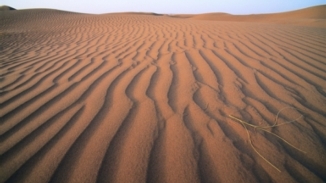
细菌乘着撒哈拉的沙尘抵达加勒比海
Saharan Dust Brings Bacterial Blooms to the Caribbean
细菌乘着撒哈拉的沙尘抵达加勒比海
Dust clouds from the Sahara reach the Caribbean—and fertilize waters there when they arrive.
来自撒哈拉的尘云到达加勒比海——为所达之处的海域带去营养。
撰文:Christopher Intagliata
翻译:陈旭琦
审校:吴非
统筹:李轩
Residents of the southern U.S. might be familiar with this dusty summer phenomenon:
[TV Weather montage: "We are breathing dust that at one point originated over Africa… Dust particles are carried 15,000 feet into the atmosphere… Another dust cloud from Africa's Sahara Desert has made it all the way to Houston."]
美国南部的居民可能对这种夏天尘土飞扬的现象很熟悉。[电视上天气预报的声音:“我们正在呼吸着从非洲而来的灰尘……这些粉尘被携带至15000英尺(约4572米)高的大气中……另一团来自非洲撒哈拉沙漠的尘云已经抵达休斯顿。”]
The dust clouds surf on trade winds towards the Caribbean. And since the dust is rich in minerals, like iron, it's like an airborne delivery of fertilizer to marine life there.
信风将尘云吹向加勒比海地区。由于沙尘中的含铁矿物丰富,这些通过空气运输的沙尘成为加勒比海地区海洋生物的肥料。
"So when you get this pulse of iron that comes, it's a micronutrient, a trace metal that's needed by all of life that's all of a sudden available, at least for a short amount of time." Erin Lipp, a microbiologist at the University of Georgia. She and her team studied the phenomenon, sampling waters in Barbados and the Florida Keys. And they found that these fertilizer dumps seem to encourage bacterial blooms. Including Vibrio species, some of which can cause cholera or food poisoning.
“铁是一种所有生物都不可或缺的微量营养元素,所以当铁元素被送达时,至少是在短时间内,这一区域内的铁含量突然变得十分充沛。”佐治亚大学的微生物学家Erin Lipp介绍道。为了研究了这种现象,她和她的团队对巴巴多斯和弗罗里达群岛的水域进行采样。他们发现这些沉降至海水中的肥料似乎有助于细菌数量的暴发。这其中就包括弧菌(Vibrio),一些弧菌可以造成霍乱或者食物中毒。
"Vibrio and probably other bacteria that are really capable of responding to this feast that's provided to them, they just use it quite rapidly. So within that first 24 hours you see a very big population spike of these bacteria." A spike of five to 30 times their usual numbers. The finding is in the Proceedings of the National Academy of Sciences. [Jason R. Westrich et al., Saharan dust nutrients promote Vibrio bloom formation in marine surface waters]
“弧菌,或许还有其他细菌,享受着这道营养盛宴,它们的“进食”速度很快。所以你可以看到,细菌数量在最初的24小时内快速增加。”其数量是平时数量的5到30倍。这一发现发表于《美国国家科学院院刊》(Proceedings of the National Academy of Sciences)。
If all this makes you want to skip the oysters after a sandstorm, "I would say that is a personal decision. But summer in general is the riskiest time to eat oysters." For now, she says, there's really no evidence to link Saharan dust to your risk of a bum oyster. So keep calm, and slurp on.
如果这让你放弃食用沙暴后的牡蛎,“我想说,这是个人的选择。但是总体上,夏季食用牡蛎风险最高。”Erin表示,目前并没有证据证明撒哈拉的沙尘和食用牡蛎的风险之间有任何关系。所以保持冷静,享用美食。
未经书面许可任何人不得复制或镜像
京ICP备11000850号-1
 京公网安备11010502039775号
京公网安备11010502039775号 信息网络传播视听节目许可证0111611号
国家科技基础条件平台

















